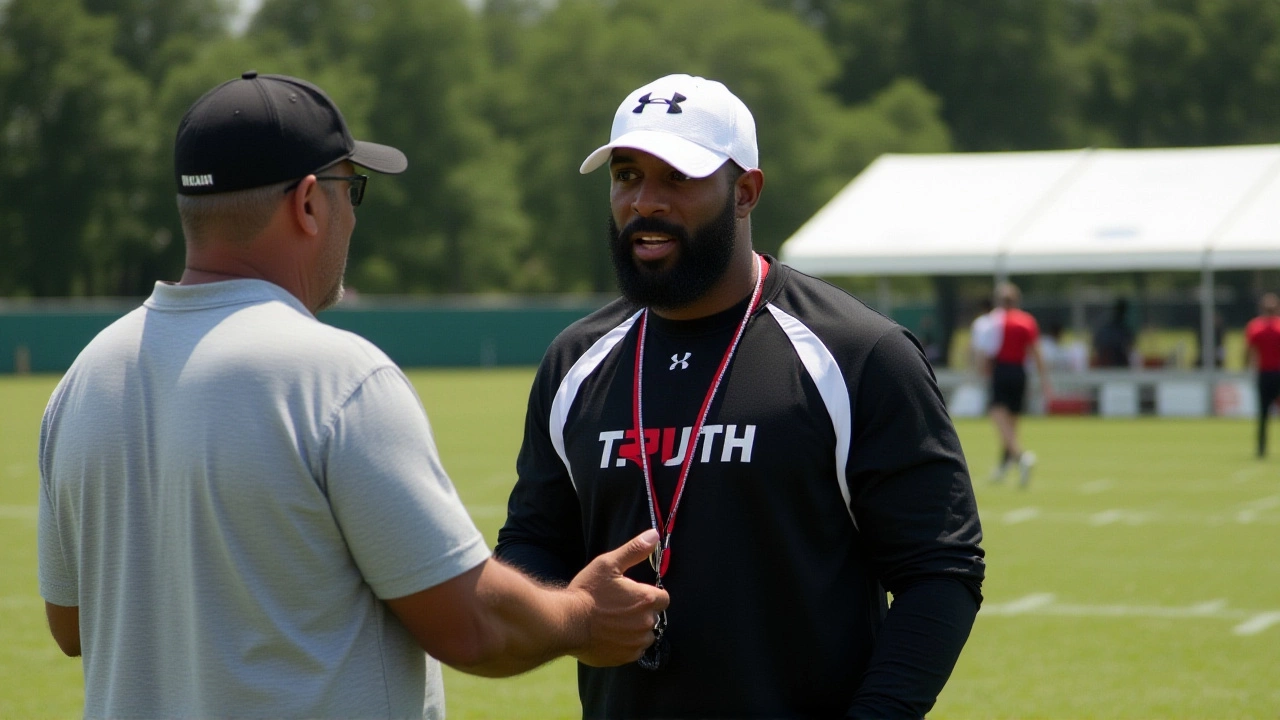It wasn’t supposed to end like this. On a cold November night at Folsom Field, with the Colorado Buffaloes’ 2025 season hanging by a thread, the Arizona State Sun Devils didn’t just win—they dismantled the home team with a fourth-quarter explosion that left fans speechless. The final score: 42-17. The turning point? A fumble. An 88-yard touchdown run. And a performance by Raleek Brown that will be replayed in Tempe for years.
The Fourth Quarter That Broke Colorado
Through three quarters, it was a game. Colorado had clawed back from a 13-7 deficit to tie it at 17-17 after a gritty 10-point third quarter. Fans were stirring. The defense was holding. Then, with 13:12 left, it all unraveled.
On a critical third-and-4, Arizona State’s Jeff Sims hit receiver Jalen Robinson on a check-down. The ball popped loose. Colorado’s defense recovered—only to see Brown, who’d been held to 47 yards through three quarters, take the next handoff and blast through the middle like a freight train. He didn’t just break tackles—he erased them. An 88-yard touchdown. The crowd went silent. The Sun Devils’ sideline erupted.
"Two plays to me changed the whole course of the game," said Deion Sanders, Colorado’s head coach, later. "The fumble. Then the explosion. That’s when we lost our rhythm—and our belief."
Raleek Brown’s Historic Night
Brown didn’t just score twice—he rewrote Arizona State history. His 255 rushing yards were the third-most in program history, trailing only the legendary 279-yard performance by Marion Butts in 1987 and 260 by D.J. Foster in 2013. He added 33 yards receiving. His two touchdowns came on runs of 88 and 12 yards. He averaged 9.1 yards per carry. And he did it while Arizona State committed four turnovers.
It was a performance that defied logic. The Sun Devils’ offense was sloppy—Sims completed just 11 of 24 passes, threw two interceptions, and was sacked three times. But Brown carried the load like a man possessed. He ran between the tackles. He broke outside. He spun away from three defenders on his final TD. By game’s end, he’d touched the ball 31 times. The Arizona State Sun Devils racked up 580 total yards despite the mistakes.
"He’s not just a runner," said ASU offensive coordinator Kevin Sumlin after the game. "He’s a playmaker who reads defenses like a chess grandmaster. Tonight, he was unstoppable."
Colorado’s Season Fades to Black
For the Colorado Buffaloes, this loss sealed a disastrous 3-8 season. Their 1-7 conference record leaves them dead last in the Big 12. They scored only 17 points in their final home game—a far cry from the 38-point average they managed in their three wins earlier this year.
They had moments. Quarterback Ethan Lewis scrambled for 67 yards and a touchdown. Running back Draymond Miller added 82 yards on 18 carries. But turnovers killed them. Three lost fumbles. Two interceptions. And a failed fourth-and-goal from the 1-yard line in the third quarter that turned momentum irrevocably.
"We had chances," said senior linebacker Jamal Carter. "We just couldn’t hold onto the ball. When you’re playing a team like ASU, you can’t give them free points. And that 88-yarder? That wasn’t just a play. That was a statement."

Big 12 Implications: ASU Still Alive
While Colorado’s season ends next week at Kansas State, Arizona State’s hopes are still alive. With the win, the Sun Devils improved to 8-3 overall and 6-2 in the Big 12, tying them with Houston, Arizona, and Cincinnati for second place. Only Oklahoma State (0-8) sits below them.
ASU’s path to the Big 12 Championship Game now hinges on a win over Texas Tech next week and a loss by either Houston or Arizona. If they win out, they’ll likely face the winner of the Texas-TCU showdown. Their offense, led by Brown and Sims, has proven it can outscore anyone—even when it’s messy.
"We’re not done," said Brown after the game, sweat dripping from his brow. "We’ve got one more road game. Then we’re going to play for something bigger than this."
What Went Wrong for Colorado?
It wasn’t just the turnovers. It was the lack of rhythm. Colorado’s offense, which had shown flashes of explosiveness in wins over Kansas and UCF, looked disjointed. The offensive line struggled to create push, and Lewis was pressured on 11 of his 28 dropbacks.
Defensively, the Buffaloes held ASU to 3 points in the first quarter—but couldn’t adjust when Brown started finding gaps. The secondary, already thin due to injuries, gave up two long touchdown passes of 52 and 49 yards in the second half. And the special teams? A 58-yard punt return by ASU’s Jalen Robinson set up their third touchdown.
"We didn’t adapt," said defensive coordinator Tim Tibesar. "They made one adjustment. We made none. And that’s on us."

What’s Next?
Colorado closes its 2025 season on Saturday, November 29, at Kansas State. The Wildcats, at 5-6 overall and 4-4 in the Big 12, are playing for pride—and a chance to finish above .500. For the Buffaloes, it’s about pride, too. And accountability.
Arizona State, meanwhile, heads to Lubbock for a showdown with Texas Tech. A win there, combined with a Houston loss to Oklahoma, could send them to the Big 12 title game for the first time since 2013. Brown’s name is now in the Heisman conversation. And Coach Prime? He’ll be watching closely.
Frequently Asked Questions
How did Raleek Brown’s 255 rushing yards rank in Arizona State history?
Raleek Brown’s 255 rushing yards against Colorado were the third-highest single-game total in Arizona State history, trailing only Marion Butts’ 279 yards in 1987 and D.J. Foster’s 260 yards in 2013. Only three players in program history have rushed for over 250 yards in a game, making Brown’s performance one of the most dominant by a Sun Devil running back in the last four decades.
Why did Colorado’s offense collapse in the fourth quarter?
Colorado’s offense stalled after the pivotal 88-yard touchdown run by Raleek Brown, which shifted momentum and morale. The Buffaloes lost two fumbles in the final 12 minutes and failed to convert any of their three fourth-down attempts. Their offensive line, already depleted by injuries, couldn’t handle ASU’s front seven, and quarterback Ethan Lewis was pressured into three rushed throws that resulted in incompletions or interceptions.
What are Arizona State’s chances of making the Big 12 Championship Game?
Arizona State (8-3, 6-2) is tied for second in the Big 12 with Houston, Arizona, and Cincinnati. They need to beat Texas Tech next week and hope either Houston loses to Oklahoma or Arizona loses to Oklahoma State. If they finish 9-3 and one of those teams drops to 7-4, ASU would likely earn the No. 2 seed and face either TCU or Texas in the title game. Their offense, led by Brown, is potent enough to win in a shootout.
How did the 88-yard touchdown run change the game psychologically?
The 88-yard run wasn’t just a score—it was a psychological knockout. Colorado had been in control until then, with momentum and a tied game. Suddenly, they were down by 11 with 13 minutes left. The crowd, which had been loud and hopeful, fell silent. Players on the sideline looked stunned. ASU’s players celebrated like they’d already won. That’s when confidence shifted completely. No team in the Big 12 this season has come back from an 11-point deficit in the fourth quarter after a score like that.
What does this loss mean for Coach Prime’s legacy at Colorado?
Despite the 3-8 record, Coach Prime’s impact goes beyond wins. He transformed Colorado’s culture, boosted recruiting, and brought national attention to the program. But this loss underscores the gap between hype and results. If Colorado doesn’t make a bowl game this season—something they haven’t done since 2020—it could raise questions about whether the program is ready for a championship-caliber rebuild. The foundation is there. The execution still isn’t.
Why do some sources list Arizona State’s record as 7-4 instead of 8-3?
The discrepancy stems from a misreporting error on cubuffs.com, which mistakenly listed ASU’s record as 7-4. ESPN and the official Arizona State Athletics site confirm the correct record is 8-3 overall and 6-2 in the Big 12 after their win over Colorado. The error likely occurred because ASU’s win over New Mexico State was initially listed as a non-conference game with a different classification, but it was later confirmed as a valid win for bowl eligibility purposes.
